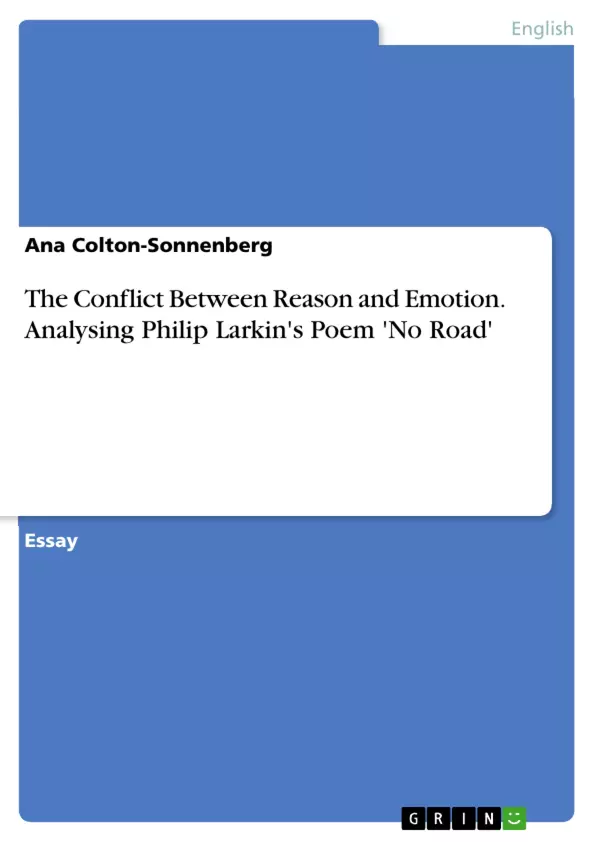The title of Philip Larkin’s “No Road” already introduces the reader to the gloomy atmosphere prevailing in the poem. In it, the persona reflects the process of letting-go of his former partner after the mutually agreed end of their relationship. Despite the strong feelings that both partners still seem to have for each other, it is not possible for them to stay together. What the poem is essentially about is the eternal human conflict between ratio and emotion. Central to this topic is the suffering caused by this antagonism. The principle devices used to communicate the theme of suffering in the poem are the narrative framework and the language. The latter is full of imagery, simile, alliteration, enjambment, and litotes. How these devices work in the communication will be discussed in the following.
Inhaltsverzeichnis (Table of Contents)
- The Title and the Metaphor of the Road
- Imagery
- Alliteration
- Enjambment
- Litotes
- Conclusion
Zielsetzung und Themenschwerpunkte (Objectives and Key Themes)
The essay aims to analyze the poem "No Road" by Philip Larkin, focusing on the communication of the theme of suffering caused by the conflict between reason and emotion. It examines how the narrative framework and various stylistic devices, including imagery, simile, alliteration, enjambment, and litotes, contribute to this theme.
- The eternal conflict between reason and emotion
- The suffering caused by this conflict
- The use of narrative framework to convey emotion
- The role of imagery in establishing atmosphere and symbolism
- The function of stylistic devices in enhancing the meaning of the poem
Zusammenfassung der Kapitel (Chapter Summaries)
- The Title and the Metaphor of the Road: This section introduces the poem's title and its significance as a metaphor for the broken bond between the lovers. It discusses the imagery of "bricked our gates up" and "planted trees to screen us" as symbols of the finality of their separation.
- Imagery: This section examines the use of imagery in the poem, particularly the metaphor of the road and its deterioration. It explores how the imagery of a neglected garden conveys a sense of hope for a potential reconciliation while the final stanza depicts the complete breakdown of the connection between the lovers.
- Alliteration: This section analyzes the use of alliteration in the poem, highlighting the harsh alliteration in the first stanza that underscores the difficulty of letting go and the softer, soothing alliteration in the second stanza that suggests hope. The final stanza sees the return of harsh alliteration, reflecting the persona's despair and helplessness.
- Enjambment: This section discusses the role of enjambment in conveying the conflict between reason and emotion. It explores how the end-stopped lines represent containment and rationality, while the enjambed lines depict the persona's emotional turmoil and the inability to hold back his feelings.
- Litotes: This section examines the use of litotes in the last stanza, emphasizing the persona's internal conflict and his denial of the possibility of preventing the final breakdown of the relationship. The placement of this litotes in the final position underscores the persona's desperation and suffering.
Schlüsselwörter (Keywords)
The key concepts and terms explored in this essay are reason, emotion, suffering, narrative framework, imagery, simile, alliteration, enjambment, and litotes. These elements are central to understanding the poem's exploration of the universal human conflict between rational thought and emotional experience.
- Arbeit zitieren
- Ana Colton-Sonnenberg (Autor:in), 2006, The Conflict Between Reason and Emotion. Analysing Philip Larkin's Poem 'No Road', München, GRIN Verlag, https://www.hausarbeiten.de/document/71208


